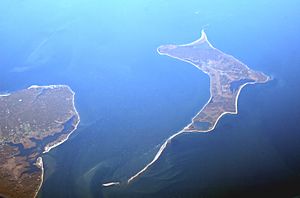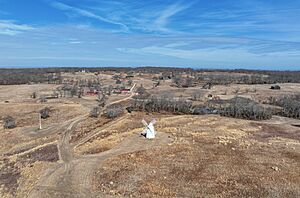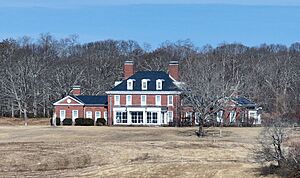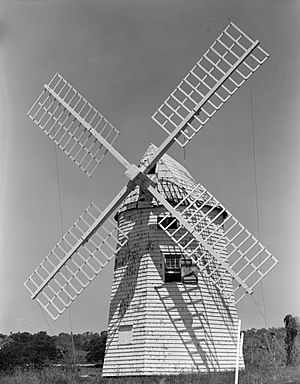Gardiners Island facts for kids

Gardiners Island in 2007
|
|
| Geography | |
|---|---|
| Location | Gardiners Bay |
| Total islands | 2 |
| Area | 5.184 sq mi (13.43 km2) |
| Administration | |
|
United States
|
|
| State | New York |
| County | Suffolk County |
<mapframe text="Gardiners Island" width=304 height=242 zoom=11 latitude=41.096667 longitude=-72.104167/> Gardiners Island is a special island in New York. It is located in Gardiners Bay in Eastern Suffolk County. The island is part of the Town of East Hampton. It sits between the two peninsulas at the east end of Long Island.
The island is about 6 miles (9.7 km) long and 3 miles (4.8 km) wide. It has 27 miles (43 km) of coastline. What makes Gardiners Island unique is that it has been owned by the same family, the Gardiner family, since 1639. This makes it one of the largest privately owned islands in the United States.
Contents
Island Geography and Nature
Gardiners Island covers about 5.19 square miles (13.4 km2). This includes over 1,000 acres (400 ha) of very old forests. There are also 1,000 acres (400 ha) of open meadows. Many of the buildings on the island are very old, some dating back to the 1600s.
Trees and Wildlife
The island has the biggest group of white oak trees in the American Northeast. You can also find swamp maple, wild cherry, and birch trees.
Gardiners Island is a very important place for wildlife. It is home to New York state's largest group of ospreys. Ospreys are large birds of prey that eat fish. What's amazing is that on Gardiners Island, these birds build their nests on the ground. This is rare because they usually nest high up. They do this here because there are no natural predators on the island to bother them.
Buildings and Structures
Besides the main family house, called the Manor House, there are other interesting buildings on the island. These include the Gardiners Island Windmill and a private airstrip on the south side.
There is also a carpenter's shed that some people believe was built in 1639. This would make it the oldest surviving wood-frame building in New York state. However, some historians are not sure if this is true because there are no old records to prove it.
Island History
First English Settlement
The island was first settled by Lion Gardiner in 1639. He moved there with his family from the Connecticut Colony. He bought the island from the local Montaukett people. The story says he traded "a large black dog, some powder and shot, and a few Dutch blankets" for it. The Montauketts called the island Manchonake. Gardiner first named it Isle of Wight because it reminded him of an island in England. The Montauketts agreed to sell it partly because Gardiner had helped them in the Pequot War.
The island was not part of the British colonies of Connecticut or Rhode Island. It was also not part of the Dutch colony of New Netherlands. Instead, it was under the control of Earl of Stirling, William Alexander. He had been given Long Island by the King of England. Gardiner had to get his permission to own the island. The island has been privately owned by Gardiner's family for over 380 years.
In 1639, the King of England gave Gardiner a special document called a "royal patent." This document gave him the right to own the land forever. It also made the island a special type of colony called a proprietary colony. Gardiner was given the title of Lord of the Manor. This meant he had special rights, like being the governor of the island.
Later, in 1665, the British took over New Netherlands and created the Province of New York. The first governor, Richard Nicolls, gave a new patent to Lion Gardiner's son, David. This confirmed the family's ownership.
In 1688, there was an attempt to make Gardiners Island part of the East Hampton government. But the Gardiner family successfully fought against this. Gardiners Island stayed independent until after the American Revolution. After the Revolution, it officially became part of East Hampton.
Lion Gardiner started a farm on the island. He grew crops like corn, wheat, fruit, and tobacco. He also raised animals.
Captain Kidd's Treasure
A famous privateer named William Kidd visited Gardiners Island in June 1699. He was on his way to Boston to face charges of piracy. With permission from the island's owner, he buried a chest, a box of gold, and two boxes of silver. He hid them in a ravine near the Manor House.
Kidd told Mrs. Gardiner that the gold was for the Governor of the Massachusetts Bay Colony. He gave Mrs. Gardiner a piece of gold cloth and a bag of sugar to thank her for her kindness.
A popular story says that Kidd threatened to kill the Gardiners if the treasure was not there when he returned. However, records from his trial do not mention any threats. It seems Kidd was quite polite.
Kidd was later tried in Boston. Governor Bellomont ordered John Gardiner, the island's owner at the time, to bring the treasure as evidence. The treasure included gold dust, silver bars, Spanish dollars, rubies, diamonds, and other valuable items. John Gardiner kept one of the diamonds and later gave it to his daughter. Today, a marker on the island shows where the treasure was buried.
American Revolution Events
During the American Revolution, the Gardiner family supported the American colonists. A group of thirteen British ships sailed into Cherry Harbor on the island. They began taking supplies and valuables from the Manor House. The British even planned to turn the island into a private hunting area.
Important British officers like Henry Clinton and John André were among them. At one point, Major André and Gardiner's son, Nathaniel Gardiner, shared a friendly toast on the island. Nathaniel Gardiner was a surgeon for the American army. He was the American doctor who later cared for André before André was executed for spying.
After the Revolution, Gardiners Island officially became part of the town of East Hampton.
War of 1812 Events
During the War of 1812, a British fleet of seven large warships and several smaller ships anchored in Cherry Harbor. They used the harbor to launch attacks on American ships in Long Island Sound. British crews would come ashore to buy supplies from the island.
At one point, Americans captured some British crew members. The British then tried to arrest the island's owner, John Lyon Gardiner. He pretended to be very sick, staying in bed with green curtains around him and medicine nearby. The British did not want a sick person on their ship, so they left him alone.
The British buried several of their soldiers on the island during the war. Some of the British ships that later burned Washington, D.C. gathered in Cherry Harbor in 1814.
Later 19th and 20th Century History
Julia Gardiner Tyler, who became the First Lady of the United States in 1844, was born on Gardiners Island in 1820. She was the second wife of President John Tyler.
Gardiners Point Island is a small island near Gardiners Island. It used to be connected to Gardiners Island. The U.S. government bought a piece of land there in 1851 to build the Gardiners Island Lighthouse. The lighthouse was first lit in 1855.
In 1888, a big storm caused the land connecting it to Gardiners Island to break apart. This turned Gardiners Point into a separate island. The lighthouse eventually fell into the ocean in 1894.
During the Spanish–American War, the U.S. government planned to build a fort called Fort Tyler on Gardiners Point Island. However, the fort was never fully armed. The shifting sands caused problems, and the fort was abandoned in the late 1920s.
In 1938, Gardiners Point Island became a National Wildlife Refuge. During World War II, the old Fort Tyler was used for target practice and was mostly destroyed. Today, it is still privately owned.
In 1947, the main Manor House on Gardiners Island burned down. It was thought that a guest fell asleep while smoking. Many valuable old items were lost. Because it was so expensive to keep up, the island was put up for sale in 1937. A wealthy relative, Sarah Diodati Gardiner, bought it for $400,000. She built a new 28-room Manor House. When she passed away in 1953, the island was left to her nephew, Robert David Lion Gardiner, and her niece, Alexandra Gardiner Creel.
From 1955 to 1963, a company called Sperry Rand leased the island for important meetings. After that, Robert David Lion Gardiner and Alexandra Gardiner Creel lived on the island.
In 1967, Gardiners Island was named a National Natural Landmark. This was because of its important role as a home for waterfowl and shorebirds, and as a breeding ground for ospreys.
Ownership Disputes
Sarah Diodati Gardiner had also set up a fund to help pay for the island's upkeep. But this money ran out by the 1970s. When Alexandra Gardiner Creel passed away, her share of the island went to her daughter, Alexandra Creel Goelet.
Robert David Lion Gardiner and Alexandra Creel Goelet had a public disagreement over who owned the island and what should happen to it. Robert accused Alexandra of wanting to sell and develop the island. She said he was not paying his share of the island's costs, which were about $2 million per year. Robert said he would not mind if the government or a nature group owned the island.
The case went to court in 1980. At first, Robert was not allowed to visit the island. But in 1992, the courts ruled that he could visit. However, the Goelets and Robert were not on the island at the same time.
Robert Gardiner, who called himself the "16th Lord of the Manor of Gardiner's Island," had no children. In 1989, he tried to adopt a businessman named George Gardiner Green Jr., who was a descendant of Lion Gardiner. But this attempt was not successful. When Robert passed away in 2004, Alexandra Creel Goelet became the full owner of the island.
21st Century
In 2005, the Goelets made an agreement with the Town of East Hampton. They agreed to protect the island's natural state. In return, the town promised not to change the land's zoning or try to buy it. This agreement is set to last until 2025.
In July 2006, Gardiners Island's status as a National Natural Landmark was removed. This happened after the owner, Alexandra Creel Goelet, asked for it to be removed.
Island Owners
- Poggatacut (sachem) and Aswaw, his wife, were the original owners of Manchonat.
- Lion Gardiner, 1st Proprietor and Lord of the Manor, 1639–1663
- David Gardiner
- John Gardiner
- David Gardiner
- John Lyon Gardiner I
- Joseph Gardiner Jr., 1992
- David Johnson Gardiner, 1825–1829
- John Gardiner, 1829–1861
- Samuel B. Gardiner, 1861–1882
- John Lyon Gardiner II, 1882–1910
- Lion Gardiner, 1910–?
- Joseph Gardiner Sr., 1969–
- Joseph Gardiner
- Sarah Diodati Gardiner, 1937–1953
- Alexandra Gardiner Creel and Robert David Lion Gardiner, 1953–2004
- Alexandra Creel Goelet, 2004—
Notable People Connected to the Island
- Lewis A. Edwards (1811–1879), a businessman and politician from New York.
- Julia Gardiner Tyler, who was the First Lady of the United States from 1844 to 1845. She was the wife of U.S. President John Tyler.
See also
 In Spanish: Isla Gardiners para niños
In Spanish: Isla Gardiners para niños




